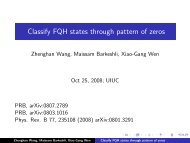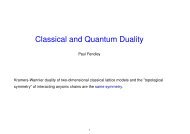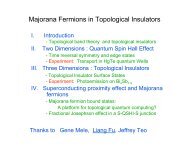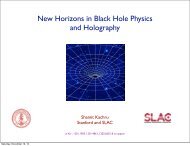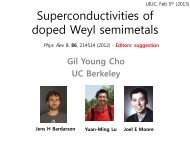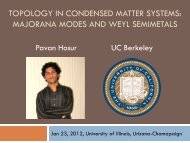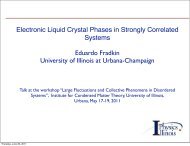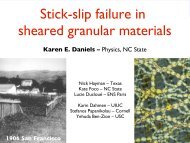Seismic Noise Correlations
Seismic Noise Correlations
Seismic Noise Correlations
Create successful ePaper yourself
Turn your PDF publications into a flip-book with our unique Google optimized e-Paper software.
<strong>Seismic</strong> <strong>Noise</strong> <strong>Correlations</strong><br />
- RL Weaver, U Illinois, Physics<br />
Karinworkshop<br />
May 2011
Over the last several years, Seismology<br />
has focused growing attention on<br />
Ambient <strong>Seismic</strong> <strong>Noise</strong><br />
and its <strong>Correlations</strong>.<br />
Citation count on one of the seminal papers:<br />
High-resolution surface-wave tomography from ambient seismic noise<br />
NM Shapiro et al SCIENCE 307 1615-1618 MAR 2005
The reason is (in part) due to the striking maps of seismic<br />
velocity that noise reveals . . .<br />
A map of Surface-Wave<br />
Velocity in California<br />
Obtained from correlating<br />
seismic noise<br />
earthquake<br />
1 year of<br />
correlations<br />
4 one-month<br />
correlations<br />
Frequencies ~0.02 < f < 1 Hz; 3km < !
Lin and Ritzwoller and Snieder (2009) Geophys J Int<br />
3 years of data on a bigger array
Tomographically generated maps of wave speed<br />
Hot spot in Yellowstone<br />
24 sec 12 sec<br />
Different properties at different frequencies<br />
i.e, different depths
They even resolve ~ 1% anisotropies in wave speed
Main Assertion of Theory:<br />
G( x, y;! ) ~ "<br />
"! < # ( x,t)# ( y,t + ! ) > ?<br />
! ( x,t)<br />
Correlation of a diffuse field<br />
gives the Green's function<br />
( + sundry fine print and qualifications)<br />
Where did this assertion come from?<br />
Why should we believe it?<br />
How much should we believe it?
History of the approach . . .<br />
Conversations with a seismologist, at a 1999 workshop,<br />
about the seismic coda - which appeared to be equipartitioned<br />
S arrival<br />
coda<br />
An earthquake record<br />
P arrival<br />
Ray arrivals are<br />
followed by<br />
low amplitude<br />
noise, or "coda"<br />
time(sec)<br />
The coda appears to<br />
achieve a steady state<br />
ratio of its energy contents<br />
For example, its shear-todilational<br />
energies: S/P<br />
Equipartition<br />
Phys Rev Lett 86 3447-50 (2001)
History of the approach continued. . .<br />
I then pointed out<br />
"if a wave field (e.g. seismic coda) is<br />
multiply scattered to the point of<br />
being equipartitioned, the field's<br />
correlations should be Green's function,<br />
And we could recover lots of information<br />
without using a controlled source"<br />
Geophysicist: "useful, if true"<br />
Physicist: "Nonsense, can't possibly be true"
Hand-waving plausibility argument . . .<br />
that there could well be a signature, an "arrival,"<br />
at the correct travel time<br />
- due to those few rays that happen to be going the right way<br />
But G exactly?<br />
And where's the proof?<br />
And won't other ray directions obscure the effect?
Standard Proofs . .<br />
•For a thermally diffuse field<br />
modal picture<br />
fluctuation-dissipation theorem<br />
•For a conventional acoustic diffuse field<br />
modal picture ( sensible only for closed systems )<br />
plane wave picture (sensible only for homogeneous systems)<br />
•Systems with uniformly distributed incoherent sources everywhere<br />
•Heterogenous loss-free region without sources,<br />
but insonified by an external diffuse field<br />
But what about imperfectly diffuse fields?<br />
• There is an asymptotic ~validity to assertion
The simplest proof involves a common definition of a fully diffuse field,<br />
from room acoustics or physics of thermal phonons:<br />
in terms of the normal mode expansion for the field in a finite body<br />
!(x,t) = U " ∞ n =1 a n u n (x) exp{i# n t}<br />
"equipartition"<br />
n.b: this follows from maximum entropy<br />
where F ~ energy per mode ( k B T )<br />
C "<br />
< ! (x, t) ! (y, t + ") > = 1 2 U # ∞ n =1F($ n ) u n (x) u n (y) exp{ % i$ n "}<br />
/$ n<br />
2<br />
Compare with G . . .<br />
G xy (!) = " ∞ n=1u n (x) u n (y) sin # n!<br />
# n<br />
[ for ! > 0 , 0 otherwise ]<br />
So, ∂C/∂# = G - G time reversed , i.e, G - G* or Im G if F is constant
Verification?<br />
e.g. . . .<br />
1.00<br />
0.75<br />
0.50<br />
!
Comparison of a<br />
Direct Pulse-Echo<br />
Signal,<br />
(conventional ultrasonics)<br />
and<br />
Thermal <strong>Noise</strong><br />
Correlation
Phys Rev Lett 87 134301 (2001)<br />
Correlation<br />
Of<br />
Thermal noise<br />
rms u ~ 3 fm/√MHz<br />
15<br />
10<br />
5<br />
0<br />
-5<br />
-10<br />
100000<br />
After<br />
Capturing<br />
320 seconds<br />
Of data<br />
(and taking 2.5<br />
hours to do so)<br />
Direct<br />
Pulse-Echo<br />
Signal<br />
.<br />
-15<br />
0.20<br />
0.15<br />
0.10<br />
0.05<br />
0.00<br />
-0.05<br />
50 100 150 200<br />
time (microsecondds)<br />
-0.10<br />
-0.15<br />
50 100 150 200<br />
time (microseconds)
But proofs that require full diffusivity<br />
and/or finite bodies and closed acoustic systems,<br />
May not be relevant for practice.<br />
Ambient seismic noise(*), for example, is<br />
NOT fully diffuse<br />
It has preferred directions (sources in ocean storms)<br />
Nevertheless, these<br />
maps are impressive<br />
Why does it work?<br />
*Late coda appears<br />
fully diffuse, but<br />
there isn't enough of it.
What if an incident field does not have isotropic intensity?<br />
What it it is not equipartitioned?<br />
Consider a homogeneous medium with<br />
incoherent sources at infinity<br />
Intensity distribution<br />
B(&)
The field in the vicinity of the origin is a superposition of plane waves<br />
! ( r,t) =<br />
% A(")exp(#ik ˆ"i r + i$t) d"<br />
( 2-d)<br />
with < A >= 0; < A(!)A * (! ') >= B(!)"(! # ! ')<br />
i.e, an incident plane wave intensity B(&)<br />
Which implies that the field-field correlation is<br />
< ! ( r,t)! ( r ',t ') >= % B(")exp(#i$ ˆ"i( r # r ') / c + i$(t # t ')) d"<br />
exact
C =< ! ( r,t)! ( r ',t ') >=<br />
% B(")exp(#i$ ˆ"i( r # r ') / c + i$(t # t ')) d"<br />
= !1<br />
4"<br />
wavelet S(t) related to power spectrum of noise<br />
2"<br />
$ +%<br />
# x 0<br />
d#i exp(i#(t ! x / c)) S(# ! # o<br />
) &<br />
{B(0)e i" /4 + B"(0) 1<br />
2# x e3i" /4 ! B(0) i<br />
8# x e5i" /4 ..)+ c.c.<br />
Leading term<br />
first correction<br />
Permits us to show that the apparent arrival time is delayed<br />
relative to |r-r'|/c by a fractional amount B"(0)/2k 2 |r-r'| 2 B(0)<br />
'The effect of non-isotropic B or arrival time is small in practice<br />
'Hence the high quality of the maps of seismic velocity<br />
even though the ambient seismic noise is not equipartitioned
Comparison of Correlation waveform (solid line)<br />
and time-symmetrized G ( dashed line)<br />
For case of non-trivial ponderosity B(&) = 1 - 0.8 cos &<br />
Froment et al<br />
2009<br />
Note: a) assertion fails, G≠dC/d#<br />
b) large differences in positive and negative time amplitudes<br />
c) there are tiny shifts of apparent arrival time, as predicted
In sum, the method works well for arrival times, hence the good maps<br />
The method is well suited to seismology because<br />
Controlled sources are highly inconvenient,<br />
(earthquakes and nuclear explosions)<br />
Recent advent of large arrays of long-period seismic stations<br />
and world-side access to their time records<br />
For many years seismologists would record seismic time-records,<br />
ignore the noise, and examine the earthquakes<br />
Now they throw out the earthquakes and keep the noise.
Other consequences of imperfectly partitioned ambient noise:<br />
Spurious features in the correlations due to scatterers<br />
Amplitude information is hard to interpret
Spurious arrivals..<br />
Intensity distribution<br />
B(&)<br />
<strong>Correlations</strong> in the presence of a scatterer will show<br />
and<br />
a direct arrival at # = |r-r'|/c<br />
an indirect arrival at # = |r-s|/c + |r'-s|/c<br />
a spurious arrival at # = |r-s|/c - |r'-s|/c<br />
} parts of G<br />
Disappears if field is<br />
equipartitioned
Amplitude information?<br />
The technique has been used very successfully in seismology to<br />
recover seismic velocities, with high spatial resolution. But . . .<br />
Arrival time is evident<br />
Arrival amplitude?<br />
Is this meaningful?<br />
If we really had G, we'd be able to infer attenuation also.<br />
Issues include the unknown field intensity in the direction<br />
between the detectors
Ray amplitudes X depend on<br />
attenuation %<br />
"on-strike" intensity B<br />
X i! j<br />
= B i<br />
( ˆn i! j<br />
) 2" / # o<br />
| r i<br />
$ r j<br />
| exp($ & %( r )d)<br />
<br />
rj<br />
<br />
r i<br />
If field is not equipartitioned, then B varies. But how?<br />
<strong>Noise</strong> intensity B varies in space like an RTE?<br />
ˆn ! "B( r , ˆn) + 2#( r )B( r , ˆn) = P( r , ˆn) +<br />
$ B( r , ˆn') p( r , ˆn, ˆn')d ˆn'<br />
sources<br />
Scattering into direction n
Another application<br />
Detecting changes in a medium . . .<br />
Brenguier et al Science: 321. 1478 - 1481(2008)<br />
correlated ocean-generated seismic noise on a daily basis<br />
from an array of seismometers in Parkfield Ca.<br />
Typical Daily Correlation between two of the stations:<br />
15000<br />
10000<br />
C ij (#)<br />
Very hard to interpret.<br />
5000<br />
0<br />
The correlations<br />
are about 80% converged.<br />
-5000<br />
-10000<br />
-15000<br />
No clear "arrivals."<br />
This is G??<br />
-100 -80 -60 -40 -20 0 20 40 60 80 100<br />
lapse time (seconds)
They then constructed dilation correlation coefficients<br />
X(() (a measure of relative stretch)<br />
( This is a 4th order statistic on the seismic field )<br />
Between the C ij on different dates and the (year-long) average C ij<br />
0.0010<br />
0.0005<br />
Parkfield earthquake<br />
of 2004<br />
0.0000<br />
-0.0005<br />
-0.0010<br />
200 400 600 800 1000 1200 1400<br />
day, starting 19 July 2003<br />
Method has been used to predict<br />
volcano eruptions
In Sum . .<br />
It has been about 12 years now, and the topic is still growing, still hot,<br />
especially in seismology<br />
Applications in<br />
High resolution seismic velocity maps<br />
Maps of attenuation too?<br />
Monitor changes in a medium<br />
Maps of scattering ?<br />
We still need better understanding<br />
of the effects of imperfectly diffuse fields.



